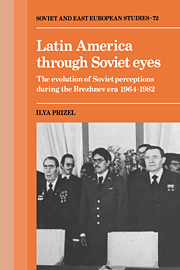 Latin America through Soviet Eyes
Latin America through Soviet Eyes Published online by Cambridge University Press: 05 February 2012
The Latin American armed forces, with the exception of the church, represent the oldest and the most enduring political institution on the continent. From the very onset of national existence the armed forces have played a key political role. Given the weakness of all other state institutions in much of Latin America and the armed forces' historical predisposition to such a role – gained during long and bloody wars of independence – this was only natural. In addition, the Iberian tradition, by which the armed forces perceived their mission as one of both defending the country from external threat and guarding the nation's destiny and integrity, left a deep imprint on most of Latin America. The presence of Prussian military training missions during the first decade of this century further reinforced this intellectual rationalization of a political role. Today, that role is confirmed, as the armed forces remain the only national institution holding together countries that are spread out across vast, impassable territories often divided by language, race, and culture.
Historically the Latin American armed forces have been identified with the most reactionary politics. Traditionally the officer corps was staffed by white criollo landed gentry, primarily concerned with preserving their status. This preoccupation was constantly manifest, from the time that Simón Bolívar (the founding father of the region's military tradition) spent his final years trying to protect the criollo elite from the “dark” masses of negroes and mestizos, to the infamous slaughter of 30,000 peasants by El Salvador's General Maximiliano Hernández Martínez in 1932, which was intended to preserve the country for the “fourteen leading families.”
To save this book to your Kindle, first ensure [email protected] is added to your Approved Personal Document E-mail List under your Personal Document Settings on the Manage Your Content and Devices page of your Amazon account. Then enter the ‘name’ part of your Kindle email address below. Find out more about saving to your Kindle.
Note you can select to save to either the @free.kindle.com or @kindle.com variations. ‘@free.kindle.com’ emails are free but can only be saved to your device when it is connected to wi-fi. ‘@kindle.com’ emails can be delivered even when you are not connected to wi-fi, but note that service fees apply.
Find out more about the Kindle Personal Document Service.
To save content items to your account, please confirm that you agree to abide by our usage policies. If this is the first time you use this feature, you will be asked to authorise Cambridge Core to connect with your account. Find out more about saving content to Dropbox.
To save content items to your account, please confirm that you agree to abide by our usage policies. If this is the first time you use this feature, you will be asked to authorise Cambridge Core to connect with your account. Find out more about saving content to Google Drive.